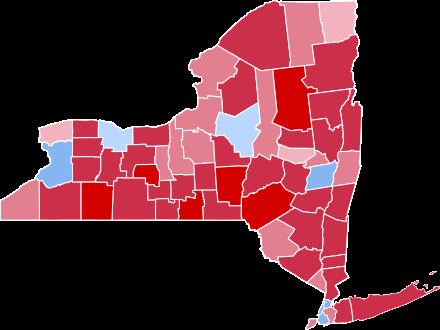47 0 2,841,163 2,780,204 45.99% 45.01% Start date November 2, 1948 | 0 0 2,780,204 509,559 45.01% 8.25% | |
 | ||
The 1948 United States presidential election in New York took place on November 2, 1948. All contemporary 48 states were part of the 1948 United States presidential election. New York voters chose 47 electors to the Electoral College, which selected the President and Vice President.
New York was won by local Republican Governor Thomas E. Dewey, who was running against incumbent Democratic President Harry S. Truman. Dewey ran with California Governor Earl Warren for Vice President, and Truman ran with Kentucky Senator Alben W. Barkley. Dewey took 45.99 percent of the vote to Truman’s 45.01 percent, a margin of 0.99 percent. Progressive Party candidate Henry Wallace, a former Democratic Vice President who ran to the left of Truman and was nominated by the local American Labor Party, finished a strong third with 8.25 percent.
New York weighed in for this election as 1% more third party than the national average, and less Democratic and Republican than the national average, despite New York being Governor Dewey’s home state.
The presidential election of 1948 was a very multi-partisan election for New York, with more than eight percent of the electorate casting votes for Third Parties. In typical form for the time, the highly populated urban centers of New York City, Buffalo, and Albany, voted primarily Democratic, while most of the smaller counties in New York turned out for Dewey as the Republican candidate.
Henry Wallace’s relatively strong third party support as a Progressive candidate was concentrated in the New York City area; in the three Democratic boroughs of New York City (Manhattan, Brooklyn, and the Bronx), Wallace took percentages in the double digits. Truman’s bleeding of left-wing support to Wallace in New York City contributed to his narrow loss of the state to Dewey, after New York had voted Democratic for Franklin Roosevelt in the preceding four elections. Although Truman lost the state, he did pick up Oneida County, which Roosevelt had lost in all his four elections and which had last been won for the Democrats in the three-way 1912 election, and before that by Grover Cleveland in 1884.
Dewey won the election in New York by a narrow margin of less than one point, despite it being his home state. Historical commentators have discussed how a major problem with the Dewey campaign was Dewey’s almost crippling aloofness to the issues of the day. Commentators suggest any Dewey speech could be boiled down to the following: “Agriculture is important. Our rivers are full of fish. You cannot have freedom without liberty. Our future lies ahead.” Many Republicans voters claimed feeling a difficulty identifying with the largely distant and enigmatic candidate. Truman, alternatively, ran a very aggressive campaign, which he focused on fighting communism, furthering the social programs established under the FDR administration, and expansion of civil rights.
The election of 1948 also greatly helped to solidify the new face of the Democratic Party as being more oriented toward human rights as backed by the Federal Government, than to states’ rights, as was previously established during the Civil War. Truman’s avocation of civil rights, particularly those of African Americans, alienated him from many southern Democrats and caused the first cracks to show in the Democratic dominance of the Deep South, which added ammunition to the growth of the Dixiecrat movement in the Deep South, though the movement enjoyed no success in New York. Rather, the major third party candidate in New York during this tumultuous election year was former United States Vice President and new Progressive Party poster child Henry Wallace, who gained over eight percent of the vote in the state.
The most populous state in the country at the time, this was the first presidential election since 1916 where New York did not back the winning candidate. Truman is also the last Democrat to win a presidential election without New York.
Results by county
NOTE: Only votes for Dewey, Truman, and Wallace are currently displayed in Full.
